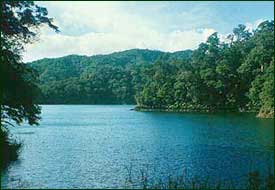Deforestation
Causes and Effects
This site is under redevelopment. Its content is from 1998, but we will be updating it in the near future.
When the first humans arrived in the Philippines from adjacent Asia many thousands of years ago, they found an archipelago that was remarkably rich in natural resources. The seas were inhabited by the earth's most diverse marine communities on earth, providing an abundant source of food throughout the year. The land was covered almost entirely by rain forest that provided them with meat from wildlife, building materials, and seemingly everlasting supplies of clear, cool water.
Those natural resources have been squandered, so badly damaged by over-use, mismanagement, and greed that recovery is uncertain, and collapse seems to be a real possibility. The nation now faces stark alternatives: a decline from the biologically richest place on earth to environmental devastation, or recovery from the current brush with disaster to a point of stability. To understand the origin of this dramatic and terrible situation, we must begin with history, but must end with societal and personalchoice.
The Lost Forest
Few countries in the world were originally more thoroughly covered by rain forest than the Philippines. Brazil has extensive Savannah and brush; Indonesia has many dry islands; Kenya and Tanzania have only small patches of rain forest. A few hundred years ago, at least 95 percent of the Philippines was covered by rain forest; only a few patches of open woodland and seasonal forest, mostly on Luzon, broke the expanse of moist, verdant land.
By the time the Spanish arrived in the Philippines in the 16th century, scattered coastal areas had been cleared for agriculture and villages. The only domestic grazer was the water buffalo, and pastureland was very limited. Some forest had been cleared in the interior as well—particularly the terraced rice lands of the Central Cordillera of northern Luzon—but most coastal areas and the richest of the lowlands remained completely forested, broken only by the occasional cultivated clearings. By 1600, the human population of the Philippinesprobably numbered about 500,000, and old-growth rain forest over 90 percent of the land, home to thousands of plant and animal species interacting in the web of life that sustained the human population.
At the end of more than 300 years of Spanish colonial rule, rain forest still covered about 70 percent of the Philippines. Some islands had been heavily deforested, while others remained nearly untouched. Cebu was so badly deforested that ornithologists visiting the island in the 1890s reported that they could find no old-growth forest, and the neighboring islands of Bohol and Panay had less than half of their original forest. Although the fertile lowland plains of Luzon had largely been cleared, much of the highland rain forest remained intact. Mindoro's rain forest was protected by an especially virulent strain of malaria, Palawan's by its isolation, and Mindanao's was largely left untouched because of the aggressive independence of the Moro people. The plant and animal communities retained their integrity, readily able toprovide resources to human populations in all but a few places.
In 1992, the date of the most recent forest survey, old-growth rain forest had declined to a shocking 8.6 percent. In late 1997 that percentage has probably dropped to seven percent, and perhaps further still. The extent of rain-forest destruction in the Philippines may represent another "first": In addition to probably having the highest density of both unique and endangered species in the world, its decline in old-growth forest from 70 percent to seven percent in less than a century is probably the most rapid and severe in the world. This destruction is a primary reason the Philippines is ranked as having the most severely endangered mammal and bird faunas in the world. The degradation is also responsible for the increasing floods and droughts in the country, as well as massive erosion, coral reef siltation, and groundwater depletion.

